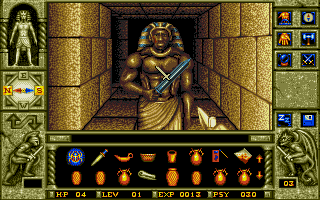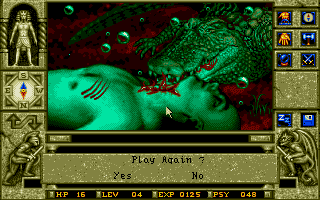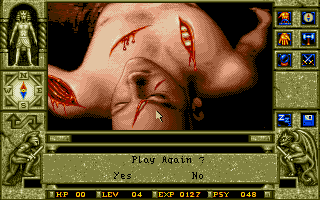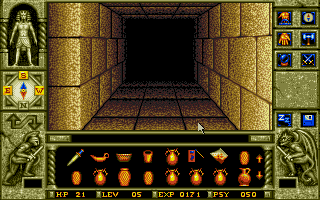From The CRPG Addict
 |
| The box CamelCases the second “W” but the title screen doesn’t. There’s a similar issue with whether the company is called HorrorSoft or Horror Soft. |
Waxworks
United Kingdom
HorrorSoft (developer); Accolade (publisher)
Released in 1992 for Amiga and DOS
Date Started: 11 June 2019
Waxworks is the fourth major title from HorrorSoft, after
. . . A Personal Nightmare (1989),
Elvira: Mistress of the Dark (1990), and
Elvira II: The Jaws of Cerberus (1991). (It is also the last; the company would re-brand itself AdventureSoft in 1993 and from then on publish essentially nothing but
Simon the Sorcerer entries. That annoys me a little bit. I mean, “AdventureSoft” is too generic a name to be taken up by a company that just publishes one series. They should have called themselves “SimonSoft” and left “AdventureSoft” for a developer with a more diverse catalog.) I think I could make a case for the game not really being an RPG, but part of me is curious to see how the developer does without Elvira as the game’s centerpiece. I never really cared for the character, which I’m sure dragged down my enjoyment of the two previous titles.
Like the Elvira games, Waxworks is fundamentally an adventure game that does offer RPG-style character development, combat, and inventory. The interface is slightly redesigned from Elvira II. (The engine is called AGOS, a graphical version of an open-source engine designed for MUDs called AberMUD.) The system of health to individual body parts has been dropped, as has the useless beating heart. The compass is moved from the lower-right to the left, and character stats are on the bottom rather than between the two main windows. A control panel of icons in the upper-left lets you check inventory, manipulate objects, ready weapon, and attack.
I bought the GOG version and was confused for a while until I looked it up and discovered that the game came with two manuals, one of which GOG doesn’t offer. The second, The Curse of the Twins, explains the backstory in 13 pages of text by Richard Moran, who also wrote the manual to Star Control II.
The backstory casts the unnamed protagonist as a twin whose brother Alex disappeared when they were teenagers. They had been exploring an old mine. The siblings lived in the seaside town of Vista Forge, where their rich, eccentric Uncle Boris built a wax museum in his creepy mansion. Now an adult, the main character has returned to Vista Forge to attend Boris’s funeral. All kinds of mysterious signs, portends, and disasters accompany the trip, including the collapse of Boris’s grave, and disappearance of his coffin when a sinkhole opens beneath the cemetery. During the chaos of this event, the protagonist thinks he briefly sees Alex in the mine tunnels that run under the cemetery.
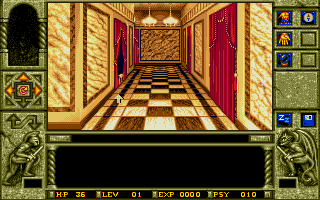 |
| The hallways of Uncle Boris’s waxworks. |
The protagonist remembers a tale that Uncle Boris once told, about a family ancestor who caught a witch named Ixona stealing one of his chickens. In retaliation, he chopped off her hand, for which Ixona cursed the family: “In every generation in which your family bears twins, one shall belong to Beelzebub.” The curse nearly immediately came true, when one twin son of the family became Vlad IV of Walachia, or Vlad the Impaler, who lived up to his name by tracking down and impaling the witch. Generations later, other twins in the family included Torquemada, the Marquis de Sade, and a female witch burned at the stake in Salem. [Having lived in Salem, I am obliged to point out with indignation that no accused witches were burned in Salem; they were all hung, except for one who was crushed under rocks. Also, they were all innocent.] It was these very individuals that Uncle Boris chose to populate his waxworks. Determined to lift the curse, Boris also funded a dig at Vlad’s castle in Walachia and recovered a crystal ball from the impaled corpse of Ixona.
The character enters the tunnels and returns to the location where Alex disappeared, finding evidence that someone has been living in the tunnels, eating bats and fish. The next day, at the reading of the will, the character inherits Boris’s estate. A letter left by Boris indicates that Boris knew Alex was still alive, and possessed by evil, and that the character can save him by using the waxworks to travel back in time and undo the curse.
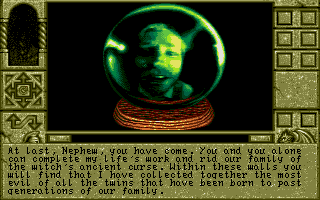 |
| Uncle Boris’s creepy, disembodied head speaks to me from beyond the grave. |
The game begins at the door to the mansion, with Boris’s butler inviting the character in. The butler gives the protagonist (whom I guess I’ll describe in the first person from now on) a crystal ball in which I see Boris’s face. He tells me that I must use the waxworks exhibits to enter the worlds of the previous twins kill them, “destroying the power that feeds the curse.” I then find myself in front of an Egyptian exhibit. The Egyptian siblings technically predate the curse, but one of them was evil, which gave Ixona the idea in the first place.
 |
| Death is only the beginning. |
I move throughout the mansion. Given the backstory, I expect to find exhibits depicting the Spanish Inquisition, the Salem Witch Trials, Dracula, and perhaps even the persecution and assassination of Jean-Paul Marat as performed by the inmates of the asylum of Charenton under the direction of the Marquis de Sade. But I guess those were just examples. What I see instead are:
- A mine being overrun by a mutant plant
 |
| Did that happen in this town? If so, the authorities sure hushed it up. |
- Jack the Ripper approaching one of his victims with a knife
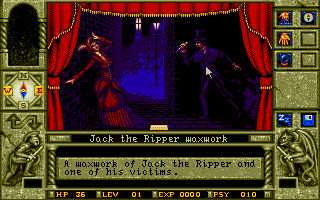 |
| You’re not even stabbed yet, woman! Don’t swoon–run! |
- A bunch of zombies lumbering through a graveyard
 |
| I’m not sure this event was “historical.” |
There are other closed curtains throughout the museum. I’m not sure if they’ll later be opened and reveal other exhibits.
I wonder if I’m supposed to take these on in a particular order, but the game has me covered there. I turns out I can talk to Boris by clicking on the crystal ball. He tells me that no, it doesn’t matter what order I choose–all of the scenes need to be “cleansed.” I realize later that talking to him has cost me “psy” points, so I’d better save it for when I’m really stuck.
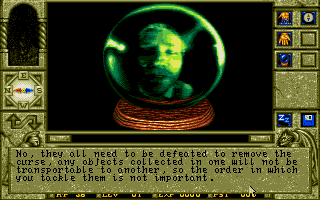 |
| . . . except that I’ll be Level 1 for the first one and like Level 20 when I go to the last one. |
I decide to go in chronological order, although I’m not entirely sure where the graveyard fits into it. My best guess is that the order is Egypt – Graveyard – Jack the Ripper – Mine. Thus, I head back to the Egyptian exhibit and choose “Enter.”
A couple of flashes of light later, and I’m in a pyramid. A nearby room shows someone labeled “pyramid designer” stabbed in the back, his body hunched over a table. A piece of papyrus underneath the corpse has an image of Anubis and a set of nine hieroglyphics.
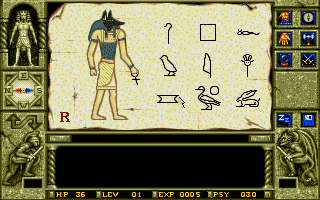 |
| Some kind of puzzle already. |
The room is full of baskets, jugs, pitchers, and other objects, and it turns out that, just as in
Elvira II, you can pick up just about everything. Unlike
Elvira II, there’s no spell system here that’s going to make use of all these items, so there’s probably no point in loading up my inventory. I do it anyway, mostly because I want to see if the 16 items the window holds are all I get, or whether it scrolls. It turns out that it scrolls. At this point, I realize that I can’t figure out how to drop things. Clicking and dragging them back to the environment doesn’t help. The manual says that “Drop” is supposed to be an object action when I click on an object, but it never appears. I hope there’s no limit to my inventory, then. I walk out of the room with a scarab beetle brooch (found in a chest), a dagger, a lamp, a bowl, a beaker, a stylus and ink block, two pieces of papyrus, three baskets, six jugs, a jar of oil, and a mat.
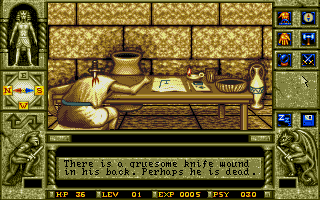 |
| The scene in the first room. Most of this stuff will end up in my inventory. |
Returning to the hallways, I start wondering if I’m going to have to map. I decide to try following the right corridor first, and if I get lost or confused, then I’ll map.
I turn a corner and meet a pyramid guard with a sword. Combat hasn’t really changed since
Elvira II, either. You hit the sword icon to activate your readied weapon, then click in the screen itself to indicate what part of the enemy you want to target. The guard defeats me three times in a row.
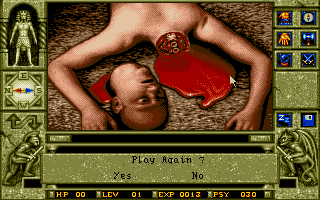 |
| And here’s where we learn that Horror Soft did not skimp on its customary gruesome death screens. |
Finally, on the fourth time, I manage to kill him–with no hit points lost. That suggests that luck is going to play a big role in combat. From this one battle, my level increases to 2. I also get the guard’s sword.
As I walk, I realize I’m getting 1 experience point for every square I’ve never stepped in before. I soon go to Level 3. This is accompanied by an increase in maximum hit points.
Continuing down the hall, I meet another guard, who also slays me two times in a row. I finally kill him on my third try. I hit him about five times for every time he hits me, and I do hundreds of points of damage to him. These guys are tanks. I begin to wonder if I was really supposed to level up in one of the easier scenarios first.
At this moment, let’s pause to note that the graphics are quite nice. Many are animated, which isn’t coming through in these static shots. But the only sound effects I’ve experienced in the game are the swishes and thuds of weapons connecting in combat. There’s music, but it’s loud and relentless and I turned it off.
 |
| This guy was a little easier. He looks easier. |
After picking up some piles of sand, I meet a new enemy: a priest with a dagger. He dies a lot easier than the guards. At the end of a corridor, at a statue, I find a tuning fork in a pot. But it isn’t long before yet another guard kills me. I reload, kill him, step a few paces past him, and find a little pond. There, a crocodile kills me while I’m trying to fill a jug with water. Man, this game is rough.
Reloading, I walk a few paces past the crocodile, then meet an Egyptian guy with a spear:
The problem is that hit points don’t seem to regenerate automatically as you move. It occurs to me that Uncle Boris might be able to help. I contact him and, sure enough, using the bits of papyrus and pen that I picked up, creates three healing scrolls. Each one seems to heal 10 hit points. They don’t really help: the spear guy destroys me in two stabs.
I start paying attention to the statistics, and when I finally kill the bastard, I’m convinced the game is just making things up. When you strike someone, the box in the lower-left corner tells how many hit points of damage you’ve done. There were times that I hit the guy for over 200 points in multiple blows and he didn’t die. When I did finally kill him, it was after maybe 80 points of damage.
I come to a treasure room! Too bad that’s not why I’m here. Five pots, a weight, two cat statues, a golden calf statue, and a tile all join my overflowing inventory.
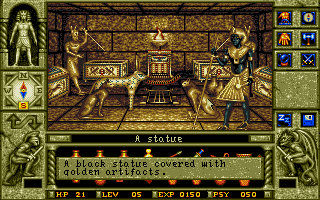 |
| In a real RPG, there would be lots of cool stuff in a room like this. |
I soon come up against a thick glass panel. Nothing will smash it. This sounds like a job for the tuning fork! After 15 minutes of rummaging through my stuff, I find it–somehow I accidentally put it into a basket. I use it and the glass shatters and collapses.
A few paces on, two blades come out of the ceiling and kill me.
Okay, it turns out that the blades are the result of a trap, indicated by the presence of a very thin piece of string stretching across the corridor. I’ll have to watch for those in the future.
I finally make it to a set of stairs upward, where I’m confronted by a puzzle: a pentagram with the number 0 at each point, plus four numbers (1, 3, 4, 6, 7) at each intersection of lines. Clicking on any of the 0s causes them to cycle through numbers 1 through 9, but it also starts an hourglass timer at the bottom. If I run out of time, as I did the first attempt (before I realized the hourglass was even running):
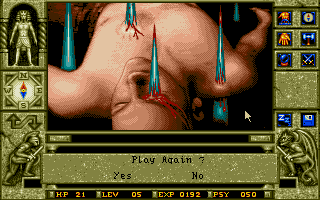 |
| The mechanism by which this happened is unclear to me. |
My guess is that it’s like a magic square: each line has to add up to the same number, with no number being used more than once, including the ones in the middle. That means I have to make do with 2, 5, 8, 9, and 0 at the points of the pentagram. It doesn’t take me long, though, to realize that isn’t going to work. The best I can do with no repeating numbers is make the totals come out to 16, 17, 18, 19, and 20.
So I focus on just getting them to add up to the same thing period. I spend some time messing with it in Excel and I finally come up with the answer, but I’m unsatisfied with my method. I know there’s a way to do it algebraically, and I just couldn’t figure it out. Solving math puzzles via trial-and-error never seems right. Anyway, I go up to Level 6.
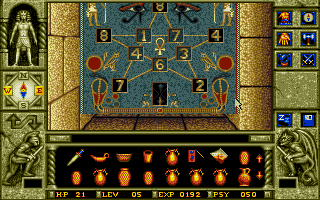 |
| Caught it just as the door was opening. |
A few steps down the corridor and:
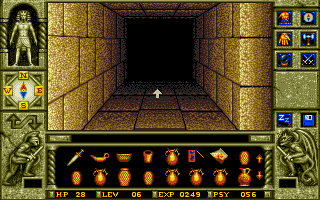 |
| How did I end up barefoot, exactly? |
I think I’ll leave it there. So far, it seems like a brisk game, but much like Elvira II, the RPG elements are unsatisfying. The deaths are kind of funny, but I wouldn’t be laughing if I prized myself on low reload count.
Time so far: 3 hours
Original URL: http://crpgaddict.blogspot.com/2019/06/game-333-waxworks-1992.html

















